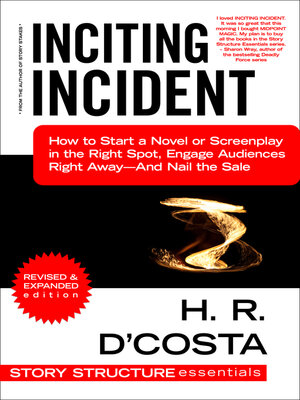Inciting Incident
ebook ∣ How to Start a Novel or Screenplay in the Right Spot, Engage Audiences Right Away—And Nail the Sale · Story Structure Essentials
By H. R. D'Costa

Sign up to save your library
With an OverDrive account, you can save your favorite libraries for at-a-glance information about availability. Find out more about OverDrive accounts.
Find this title in Libby, the library reading app by OverDrive.



Search for a digital library with this title
Title found at these libraries:
| Library Name | Distance |
|---|---|
| Loading... |
Does Your Story Beginning Set You Up for Long-Term Success...Or Instant Failure?
Ever struggled with finding the right spot to start your novel or screenplay?
It's a stressful situation, isn't it?
That's because so much is at stake.
All you want is to immediately catch the attention of your target audience (e.g. book browser, literary agent, Hollywood manager, studio executive) whose yes could change your life.
But if your story beginning is flat, boring, or bogged down by exposition, your story will be tossed back into the slush pile, and relegated to obscurity.
Alas, the beginning of a novel or screenplay has to do more than get you on the path to a sale.
You see, it also has to convey various details to your audience so they can understand and care about what happens later.
In short, your story beginning has to (a) grab audiences and (b) set your plotting pieces in place.
Problem is, each objective tends to use different pacing—one brisk, one more leisurely.
*** So. How in the World Do You Accomplish Both at the Same Time?! ***
If this is a storytelling dragon that you've grappled with in the past—perhaps for years—you will love Inciting Incident, which will show you how to banish it.
*** Imagine What It'd Be Like to Easily Craft a Successful Story Beginning... ***
The beginning of your story would be so captivating, it'd make your target audience feel tingles down their spine.
The kind of tingles that make them cancel everything else because they want to book a date with YOUR story.
But that's not all.
Later on, when you crank up the heat on your characters, your audience won't say "So what!" or "I'm so confused"—and bail on your story.
Your audience will still be right there with you—still charmed, still captivated.
Which means you won't be facing two soul-crushing outcomes: losing audiences now versus losing them later.
Instead, you'll turn this lose-lose proposition into a win.
*ahhh* Sweet relief.
That's what your writing life can be like after you read this acclaimed, deep-dive writing guide.
*** Ever Been Burning to Know... ***
—Does my story beginning have the kind of pacing and momentum that will attract my target audience...or repel them?
—Where should the inciting incident go to keep audiences hooked? Can I delay it without losing them? How much everyday world should I include?
—What starting point should I use when I know that my current one is too rushed, and I've gone too far ahead with the plot?
—How can I make audiences excited about slower, character-driven opening scenes?
—What are different ways to open my story? Do "controversial" beginnings like prologues and flashforwards ever work?
You'll find all the answers—plus more—in this easy-to-read guide to story structure.
(No fancy college theory here. Just practical, down-to-earth advice that, nevertheless, goes deep into craft.)
*** What Writers Think About This Comprehensive Guide on Story Beginnings ***
"A fantastic guide with plenty of examples. Added to my keeper shelf."
~ AMAZON REVIEWER
"I loved INCITING INCIDENT. It was so great that this morning I bought MIDPOINT MAGIC. My plan is to buy all the books in the Story Structure Essentials series."
~ SHARON WRAY, author of the bestselling Deadly Force romantic-suspense series
*** Stop Feeling Like Your Opening Pages Are—No Matter What You Do— Too...







